Medication Safety: Analyzing Errors, Impact, and Prevention Strategies
VerifiedAdded on 2023/01/05
|6
|1509
|89
Essay
AI Summary
This essay delves into the critical issue of medication safety in healthcare settings. It begins by defining medication errors and highlighting strategies to minimize their occurrence, such as proper documentation, clinical governance, and continuity of medication management. The essay then explores the root causes of medication errors, including nurse-to-patient ratio imbalances, insufficient pharmacological knowledge, and inadequate information flow and communication. It also examines the detrimental effects of medication errors on both patients and healthcare providers, including potential physical harm, psychological distress, and legal consequences. Finally, the essay emphasizes the crucial role of nurses in promoting medication safety through continuous learning, double-checking prescriptions, and patient education, ultimately aiming to reduce errors and enhance patient outcomes.
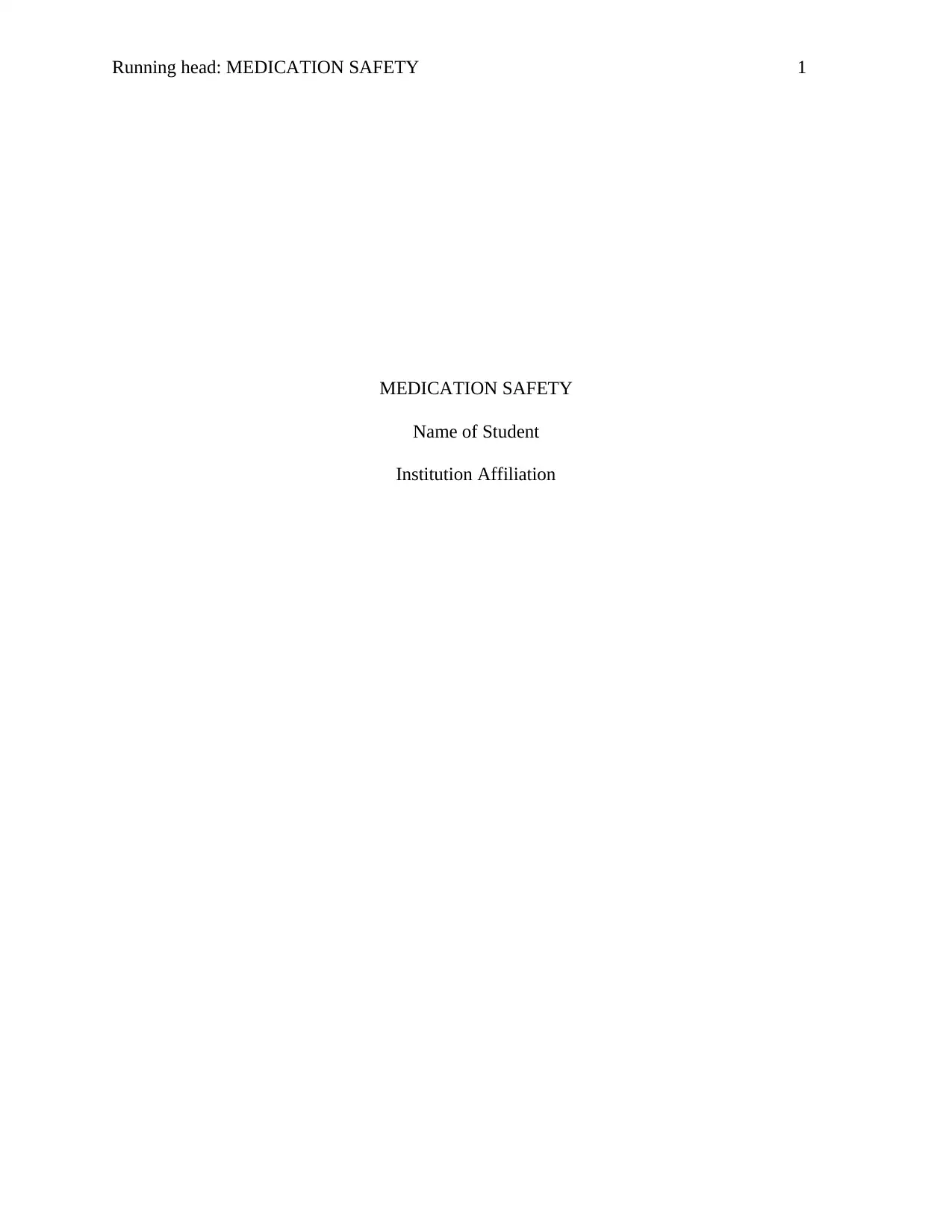
Running head: MEDICATION SAFETY 1
MEDICATION SAFETY
Name of Student
Institution Affiliation
MEDICATION SAFETY
Name of Student
Institution Affiliation
Paraphrase This Document
Need a fresh take? Get an instant paraphrase of this document with our AI Paraphraser
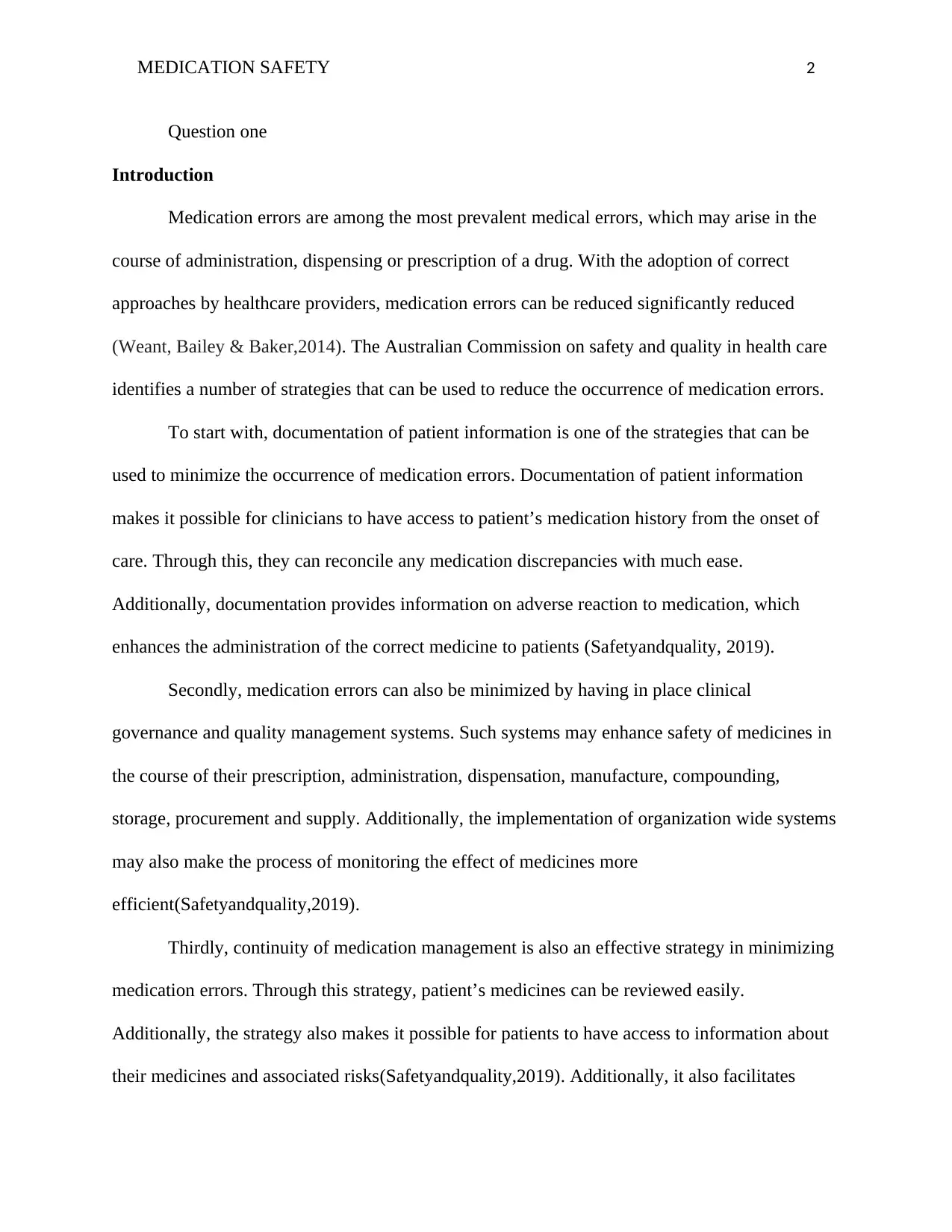
MEDICATION SAFETY 2
Question one
Introduction
Medication errors are among the most prevalent medical errors, which may arise in the
course of administration, dispensing or prescription of a drug. With the adoption of correct
approaches by healthcare providers, medication errors can be reduced significantly reduced
(Weant, Bailey & Baker,2014). The Australian Commission on safety and quality in health care
identifies a number of strategies that can be used to reduce the occurrence of medication errors.
To start with, documentation of patient information is one of the strategies that can be
used to minimize the occurrence of medication errors. Documentation of patient information
makes it possible for clinicians to have access to patient’s medication history from the onset of
care. Through this, they can reconcile any medication discrepancies with much ease.
Additionally, documentation provides information on adverse reaction to medication, which
enhances the administration of the correct medicine to patients (Safetyandquality, 2019).
Secondly, medication errors can also be minimized by having in place clinical
governance and quality management systems. Such systems may enhance safety of medicines in
the course of their prescription, administration, dispensation, manufacture, compounding,
storage, procurement and supply. Additionally, the implementation of organization wide systems
may also make the process of monitoring the effect of medicines more
efficient(Safetyandquality,2019).
Thirdly, continuity of medication management is also an effective strategy in minimizing
medication errors. Through this strategy, patient’s medicines can be reviewed easily.
Additionally, the strategy also makes it possible for patients to have access to information about
their medicines and associated risks(Safetyandquality,2019). Additionally, it also facilitates
Question one
Introduction
Medication errors are among the most prevalent medical errors, which may arise in the
course of administration, dispensing or prescription of a drug. With the adoption of correct
approaches by healthcare providers, medication errors can be reduced significantly reduced
(Weant, Bailey & Baker,2014). The Australian Commission on safety and quality in health care
identifies a number of strategies that can be used to reduce the occurrence of medication errors.
To start with, documentation of patient information is one of the strategies that can be
used to minimize the occurrence of medication errors. Documentation of patient information
makes it possible for clinicians to have access to patient’s medication history from the onset of
care. Through this, they can reconcile any medication discrepancies with much ease.
Additionally, documentation provides information on adverse reaction to medication, which
enhances the administration of the correct medicine to patients (Safetyandquality, 2019).
Secondly, medication errors can also be minimized by having in place clinical
governance and quality management systems. Such systems may enhance safety of medicines in
the course of their prescription, administration, dispensation, manufacture, compounding,
storage, procurement and supply. Additionally, the implementation of organization wide systems
may also make the process of monitoring the effect of medicines more
efficient(Safetyandquality,2019).
Thirdly, continuity of medication management is also an effective strategy in minimizing
medication errors. Through this strategy, patient’s medicines can be reviewed easily.
Additionally, the strategy also makes it possible for patients to have access to information about
their medicines and associated risks(Safetyandquality,2019). Additionally, it also facilitates
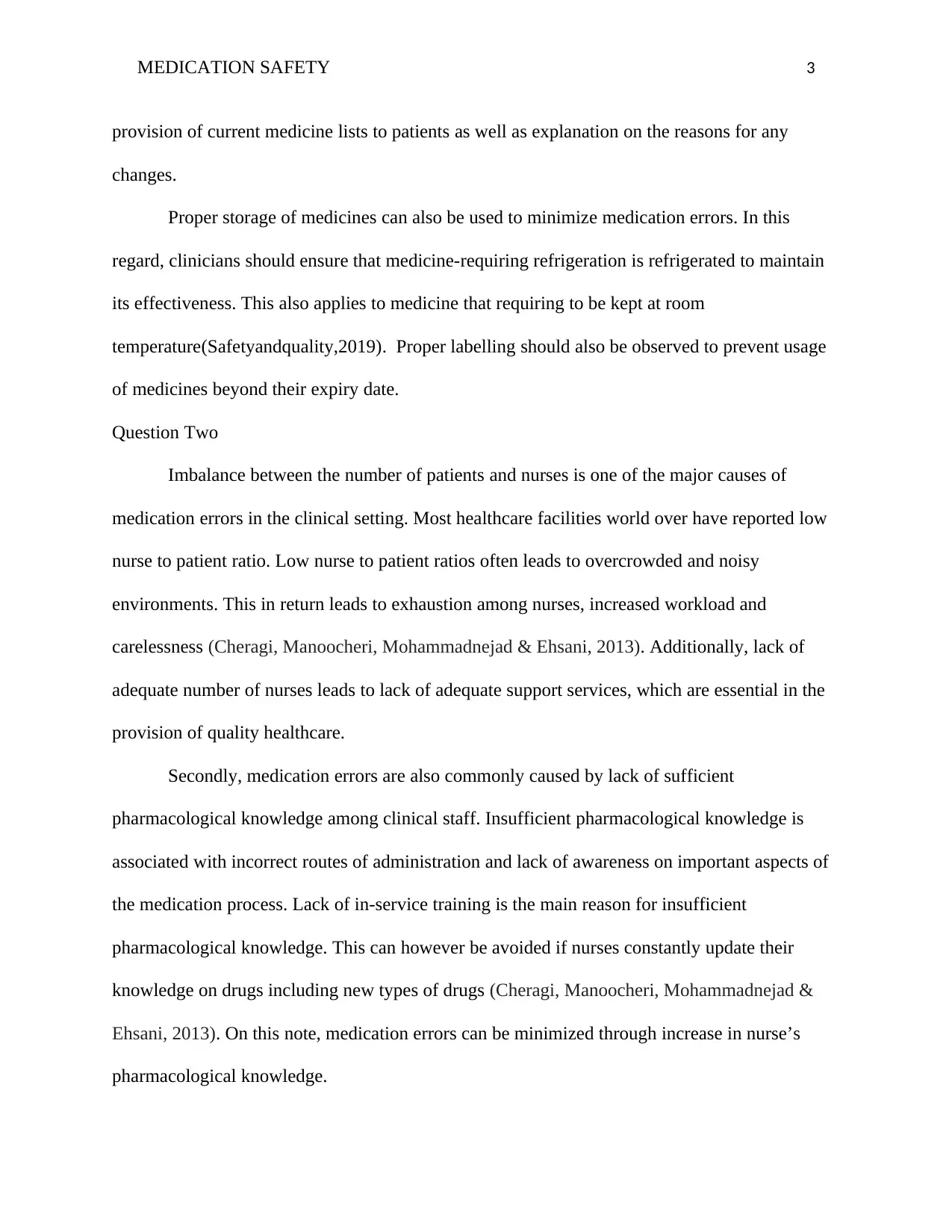
MEDICATION SAFETY 3
provision of current medicine lists to patients as well as explanation on the reasons for any
changes.
Proper storage of medicines can also be used to minimize medication errors. In this
regard, clinicians should ensure that medicine-requiring refrigeration is refrigerated to maintain
its effectiveness. This also applies to medicine that requiring to be kept at room
temperature(Safetyandquality,2019). Proper labelling should also be observed to prevent usage
of medicines beyond their expiry date.
Question Two
Imbalance between the number of patients and nurses is one of the major causes of
medication errors in the clinical setting. Most healthcare facilities world over have reported low
nurse to patient ratio. Low nurse to patient ratios often leads to overcrowded and noisy
environments. This in return leads to exhaustion among nurses, increased workload and
carelessness (Cheragi, Manoocheri, Mohammadnejad & Ehsani, 2013). Additionally, lack of
adequate number of nurses leads to lack of adequate support services, which are essential in the
provision of quality healthcare.
Secondly, medication errors are also commonly caused by lack of sufficient
pharmacological knowledge among clinical staff. Insufficient pharmacological knowledge is
associated with incorrect routes of administration and lack of awareness on important aspects of
the medication process. Lack of in-service training is the main reason for insufficient
pharmacological knowledge. This can however be avoided if nurses constantly update their
knowledge on drugs including new types of drugs (Cheragi, Manoocheri, Mohammadnejad &
Ehsani, 2013). On this note, medication errors can be minimized through increase in nurse’s
pharmacological knowledge.
provision of current medicine lists to patients as well as explanation on the reasons for any
changes.
Proper storage of medicines can also be used to minimize medication errors. In this
regard, clinicians should ensure that medicine-requiring refrigeration is refrigerated to maintain
its effectiveness. This also applies to medicine that requiring to be kept at room
temperature(Safetyandquality,2019). Proper labelling should also be observed to prevent usage
of medicines beyond their expiry date.
Question Two
Imbalance between the number of patients and nurses is one of the major causes of
medication errors in the clinical setting. Most healthcare facilities world over have reported low
nurse to patient ratio. Low nurse to patient ratios often leads to overcrowded and noisy
environments. This in return leads to exhaustion among nurses, increased workload and
carelessness (Cheragi, Manoocheri, Mohammadnejad & Ehsani, 2013). Additionally, lack of
adequate number of nurses leads to lack of adequate support services, which are essential in the
provision of quality healthcare.
Secondly, medication errors are also commonly caused by lack of sufficient
pharmacological knowledge among clinical staff. Insufficient pharmacological knowledge is
associated with incorrect routes of administration and lack of awareness on important aspects of
the medication process. Lack of in-service training is the main reason for insufficient
pharmacological knowledge. This can however be avoided if nurses constantly update their
knowledge on drugs including new types of drugs (Cheragi, Manoocheri, Mohammadnejad &
Ehsani, 2013). On this note, medication errors can be minimized through increase in nurse’s
pharmacological knowledge.
⊘ This is a preview!⊘
Do you want full access?
Subscribe today to unlock all pages.

Trusted by 1+ million students worldwide
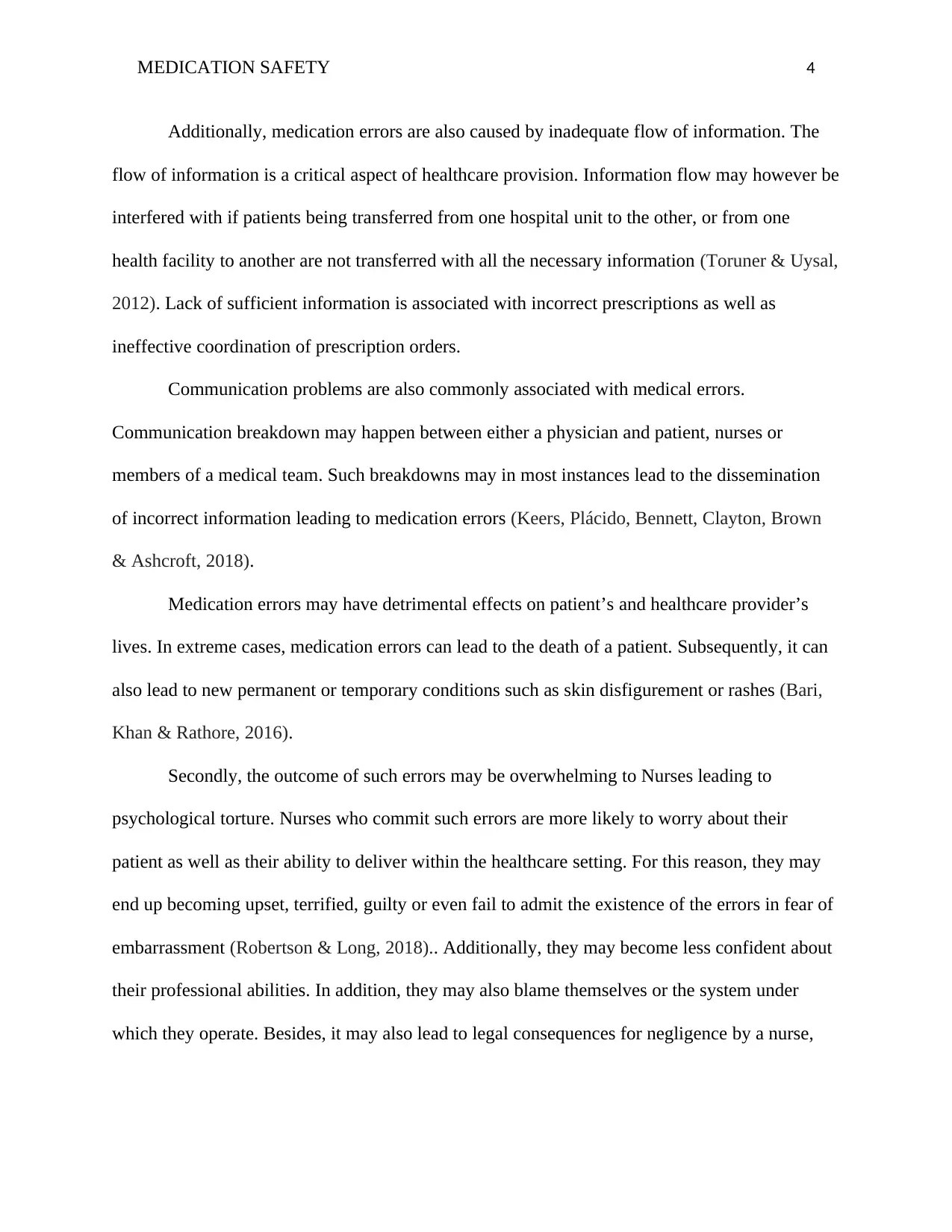
MEDICATION SAFETY 4
Additionally, medication errors are also caused by inadequate flow of information. The
flow of information is a critical aspect of healthcare provision. Information flow may however be
interfered with if patients being transferred from one hospital unit to the other, or from one
health facility to another are not transferred with all the necessary information (Toruner & Uysal,
2012). Lack of sufficient information is associated with incorrect prescriptions as well as
ineffective coordination of prescription orders.
Communication problems are also commonly associated with medical errors.
Communication breakdown may happen between either a physician and patient, nurses or
members of a medical team. Such breakdowns may in most instances lead to the dissemination
of incorrect information leading to medication errors (Keers, Plácido, Bennett, Clayton, Brown
& Ashcroft, 2018).
Medication errors may have detrimental effects on patient’s and healthcare provider’s
lives. In extreme cases, medication errors can lead to the death of a patient. Subsequently, it can
also lead to new permanent or temporary conditions such as skin disfigurement or rashes (Bari,
Khan & Rathore, 2016).
Secondly, the outcome of such errors may be overwhelming to Nurses leading to
psychological torture. Nurses who commit such errors are more likely to worry about their
patient as well as their ability to deliver within the healthcare setting. For this reason, they may
end up becoming upset, terrified, guilty or even fail to admit the existence of the errors in fear of
embarrassment (Robertson & Long, 2018).. Additionally, they may become less confident about
their professional abilities. In addition, they may also blame themselves or the system under
which they operate. Besides, it may also lead to legal consequences for negligence by a nurse,
Additionally, medication errors are also caused by inadequate flow of information. The
flow of information is a critical aspect of healthcare provision. Information flow may however be
interfered with if patients being transferred from one hospital unit to the other, or from one
health facility to another are not transferred with all the necessary information (Toruner & Uysal,
2012). Lack of sufficient information is associated with incorrect prescriptions as well as
ineffective coordination of prescription orders.
Communication problems are also commonly associated with medical errors.
Communication breakdown may happen between either a physician and patient, nurses or
members of a medical team. Such breakdowns may in most instances lead to the dissemination
of incorrect information leading to medication errors (Keers, Plácido, Bennett, Clayton, Brown
& Ashcroft, 2018).
Medication errors may have detrimental effects on patient’s and healthcare provider’s
lives. In extreme cases, medication errors can lead to the death of a patient. Subsequently, it can
also lead to new permanent or temporary conditions such as skin disfigurement or rashes (Bari,
Khan & Rathore, 2016).
Secondly, the outcome of such errors may be overwhelming to Nurses leading to
psychological torture. Nurses who commit such errors are more likely to worry about their
patient as well as their ability to deliver within the healthcare setting. For this reason, they may
end up becoming upset, terrified, guilty or even fail to admit the existence of the errors in fear of
embarrassment (Robertson & Long, 2018).. Additionally, they may become less confident about
their professional abilities. In addition, they may also blame themselves or the system under
which they operate. Besides, it may also lead to legal consequences for negligence by a nurse,
Paraphrase This Document
Need a fresh take? Get an instant paraphrase of this document with our AI Paraphraser
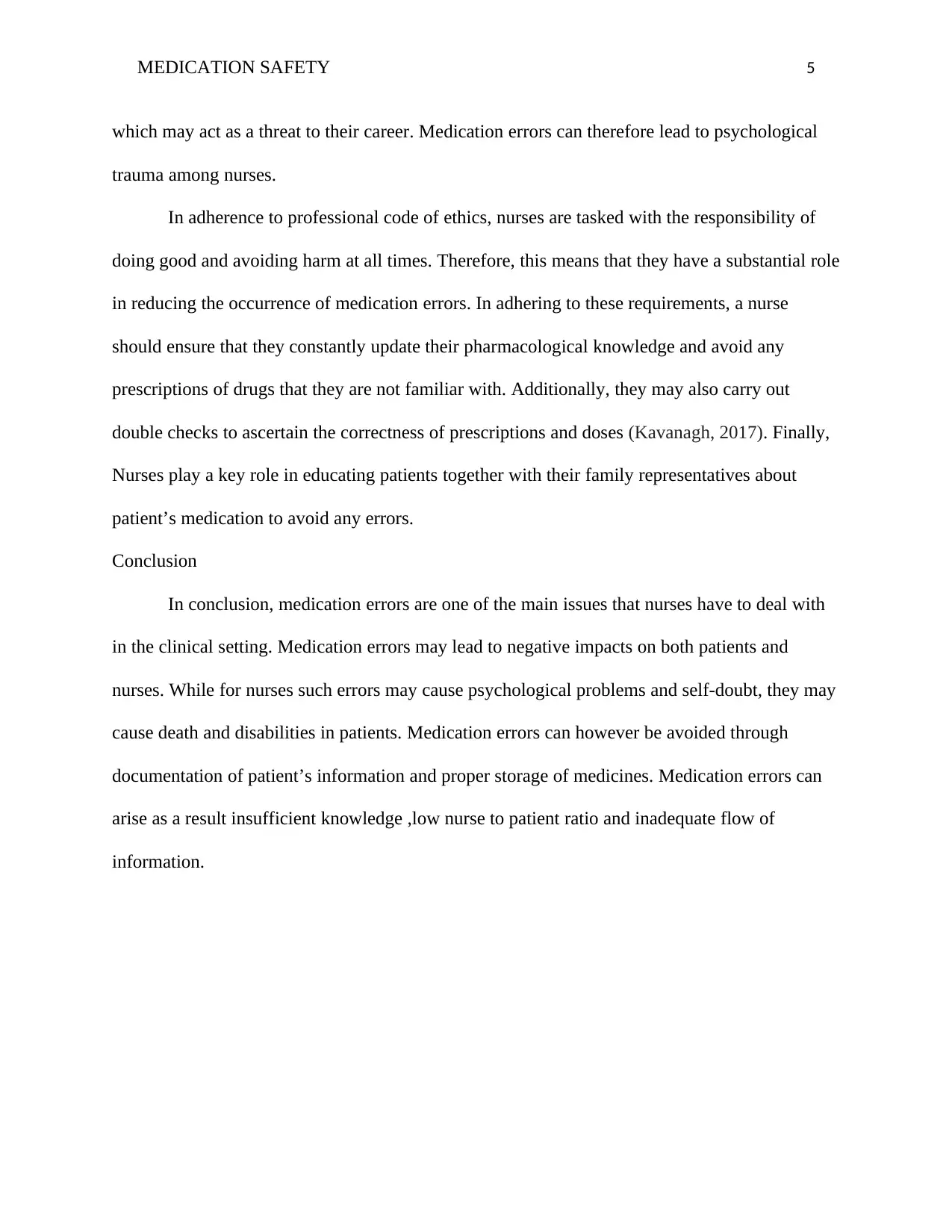
MEDICATION SAFETY 5
which may act as a threat to their career. Medication errors can therefore lead to psychological
trauma among nurses.
In adherence to professional code of ethics, nurses are tasked with the responsibility of
doing good and avoiding harm at all times. Therefore, this means that they have a substantial role
in reducing the occurrence of medication errors. In adhering to these requirements, a nurse
should ensure that they constantly update their pharmacological knowledge and avoid any
prescriptions of drugs that they are not familiar with. Additionally, they may also carry out
double checks to ascertain the correctness of prescriptions and doses (Kavanagh, 2017). Finally,
Nurses play a key role in educating patients together with their family representatives about
patient’s medication to avoid any errors.
Conclusion
In conclusion, medication errors are one of the main issues that nurses have to deal with
in the clinical setting. Medication errors may lead to negative impacts on both patients and
nurses. While for nurses such errors may cause psychological problems and self-doubt, they may
cause death and disabilities in patients. Medication errors can however be avoided through
documentation of patient’s information and proper storage of medicines. Medication errors can
arise as a result insufficient knowledge ,low nurse to patient ratio and inadequate flow of
information.
which may act as a threat to their career. Medication errors can therefore lead to psychological
trauma among nurses.
In adherence to professional code of ethics, nurses are tasked with the responsibility of
doing good and avoiding harm at all times. Therefore, this means that they have a substantial role
in reducing the occurrence of medication errors. In adhering to these requirements, a nurse
should ensure that they constantly update their pharmacological knowledge and avoid any
prescriptions of drugs that they are not familiar with. Additionally, they may also carry out
double checks to ascertain the correctness of prescriptions and doses (Kavanagh, 2017). Finally,
Nurses play a key role in educating patients together with their family representatives about
patient’s medication to avoid any errors.
Conclusion
In conclusion, medication errors are one of the main issues that nurses have to deal with
in the clinical setting. Medication errors may lead to negative impacts on both patients and
nurses. While for nurses such errors may cause psychological problems and self-doubt, they may
cause death and disabilities in patients. Medication errors can however be avoided through
documentation of patient’s information and proper storage of medicines. Medication errors can
arise as a result insufficient knowledge ,low nurse to patient ratio and inadequate flow of
information.
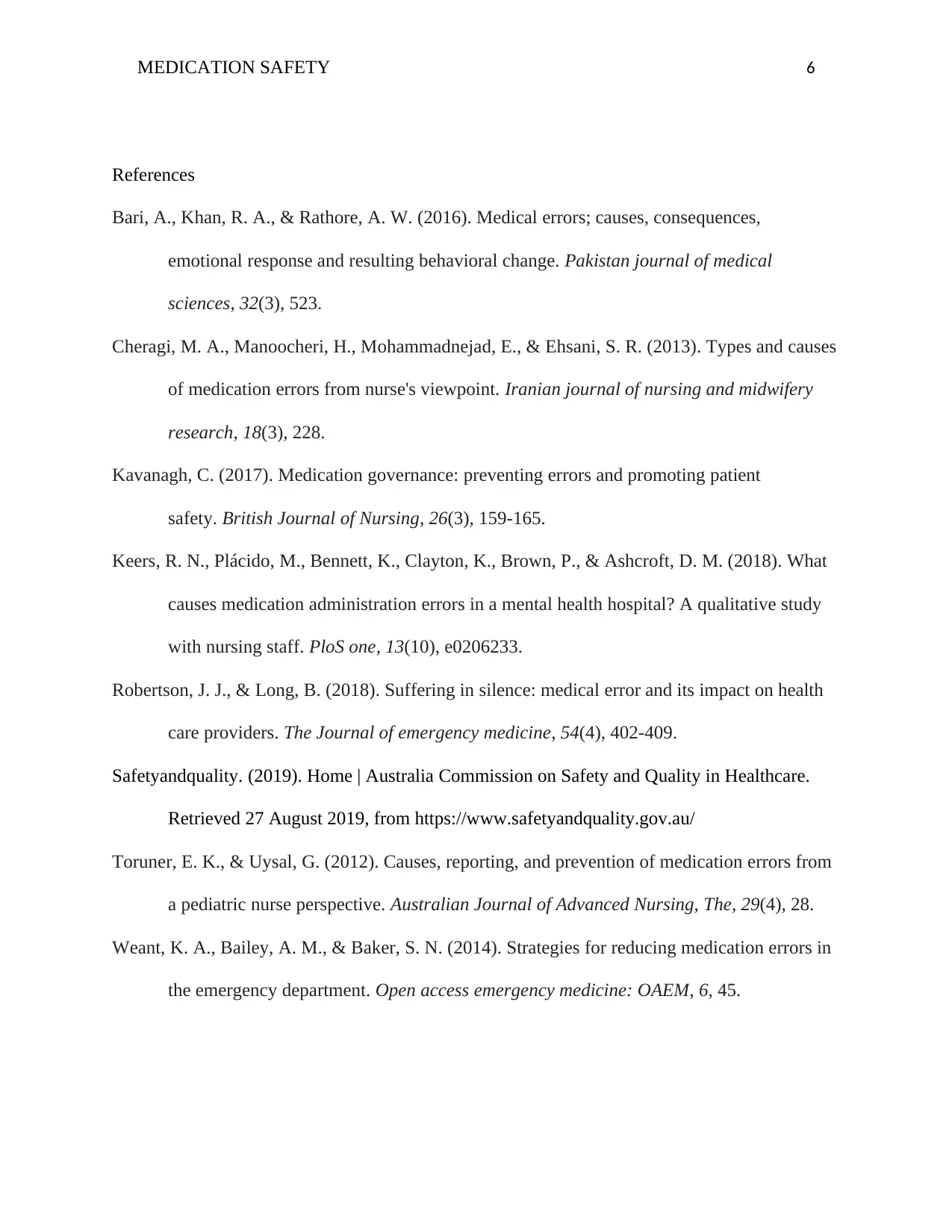
MEDICATION SAFETY 6
References
Bari, A., Khan, R. A., & Rathore, A. W. (2016). Medical errors; causes, consequences,
emotional response and resulting behavioral change. Pakistan journal of medical
sciences, 32(3), 523.
Cheragi, M. A., Manoocheri, H., Mohammadnejad, E., & Ehsani, S. R. (2013). Types and causes
of medication errors from nurse's viewpoint. Iranian journal of nursing and midwifery
research, 18(3), 228.
Kavanagh, C. (2017). Medication governance: preventing errors and promoting patient
safety. British Journal of Nursing, 26(3), 159-165.
Keers, R. N., Plácido, M., Bennett, K., Clayton, K., Brown, P., & Ashcroft, D. M. (2018). What
causes medication administration errors in a mental health hospital? A qualitative study
with nursing staff. PloS one, 13(10), e0206233.
Robertson, J. J., & Long, B. (2018). Suffering in silence: medical error and its impact on health
care providers. The Journal of emergency medicine, 54(4), 402-409.
Safetyandquality. (2019). Home | Australia Commission on Safety and Quality in Healthcare.
Retrieved 27 August 2019, from https://www.safetyandquality.gov.au/
Toruner, E. K., & Uysal, G. (2012). Causes, reporting, and prevention of medication errors from
a pediatric nurse perspective. Australian Journal of Advanced Nursing, The, 29(4), 28.
Weant, K. A., Bailey, A. M., & Baker, S. N. (2014). Strategies for reducing medication errors in
the emergency department. Open access emergency medicine: OAEM, 6, 45.
References
Bari, A., Khan, R. A., & Rathore, A. W. (2016). Medical errors; causes, consequences,
emotional response and resulting behavioral change. Pakistan journal of medical
sciences, 32(3), 523.
Cheragi, M. A., Manoocheri, H., Mohammadnejad, E., & Ehsani, S. R. (2013). Types and causes
of medication errors from nurse's viewpoint. Iranian journal of nursing and midwifery
research, 18(3), 228.
Kavanagh, C. (2017). Medication governance: preventing errors and promoting patient
safety. British Journal of Nursing, 26(3), 159-165.
Keers, R. N., Plácido, M., Bennett, K., Clayton, K., Brown, P., & Ashcroft, D. M. (2018). What
causes medication administration errors in a mental health hospital? A qualitative study
with nursing staff. PloS one, 13(10), e0206233.
Robertson, J. J., & Long, B. (2018). Suffering in silence: medical error and its impact on health
care providers. The Journal of emergency medicine, 54(4), 402-409.
Safetyandquality. (2019). Home | Australia Commission on Safety and Quality in Healthcare.
Retrieved 27 August 2019, from https://www.safetyandquality.gov.au/
Toruner, E. K., & Uysal, G. (2012). Causes, reporting, and prevention of medication errors from
a pediatric nurse perspective. Australian Journal of Advanced Nursing, The, 29(4), 28.
Weant, K. A., Bailey, A. M., & Baker, S. N. (2014). Strategies for reducing medication errors in
the emergency department. Open access emergency medicine: OAEM, 6, 45.
⊘ This is a preview!⊘
Do you want full access?
Subscribe today to unlock all pages.

Trusted by 1+ million students worldwide
1 out of 6
Related Documents
Your All-in-One AI-Powered Toolkit for Academic Success.
+13062052269
info@desklib.com
Available 24*7 on WhatsApp / Email
![[object Object]](/_next/static/media/star-bottom.7253800d.svg)
Unlock your academic potential
Copyright © 2020–2025 A2Z Services. All Rights Reserved. Developed and managed by ZUCOL.





